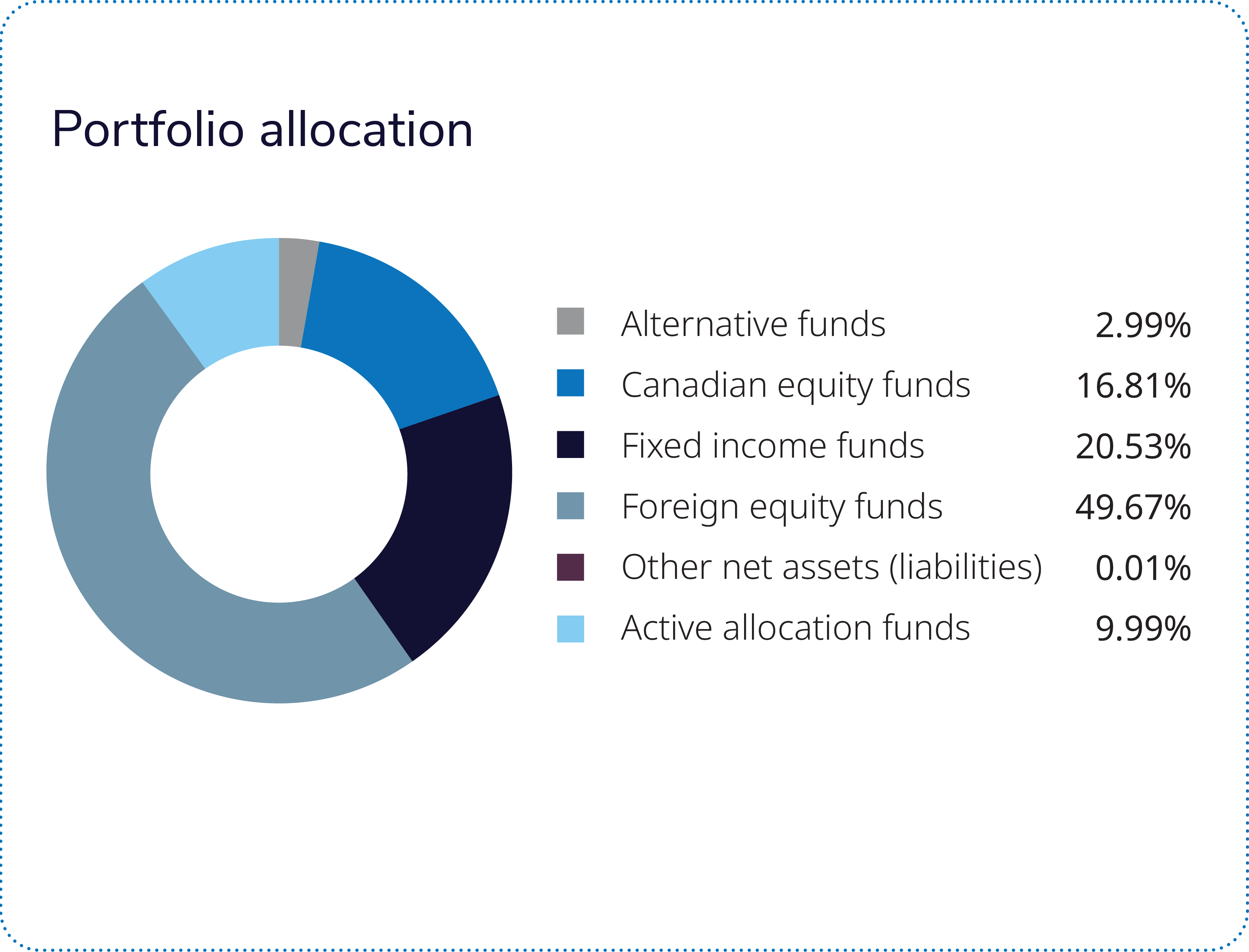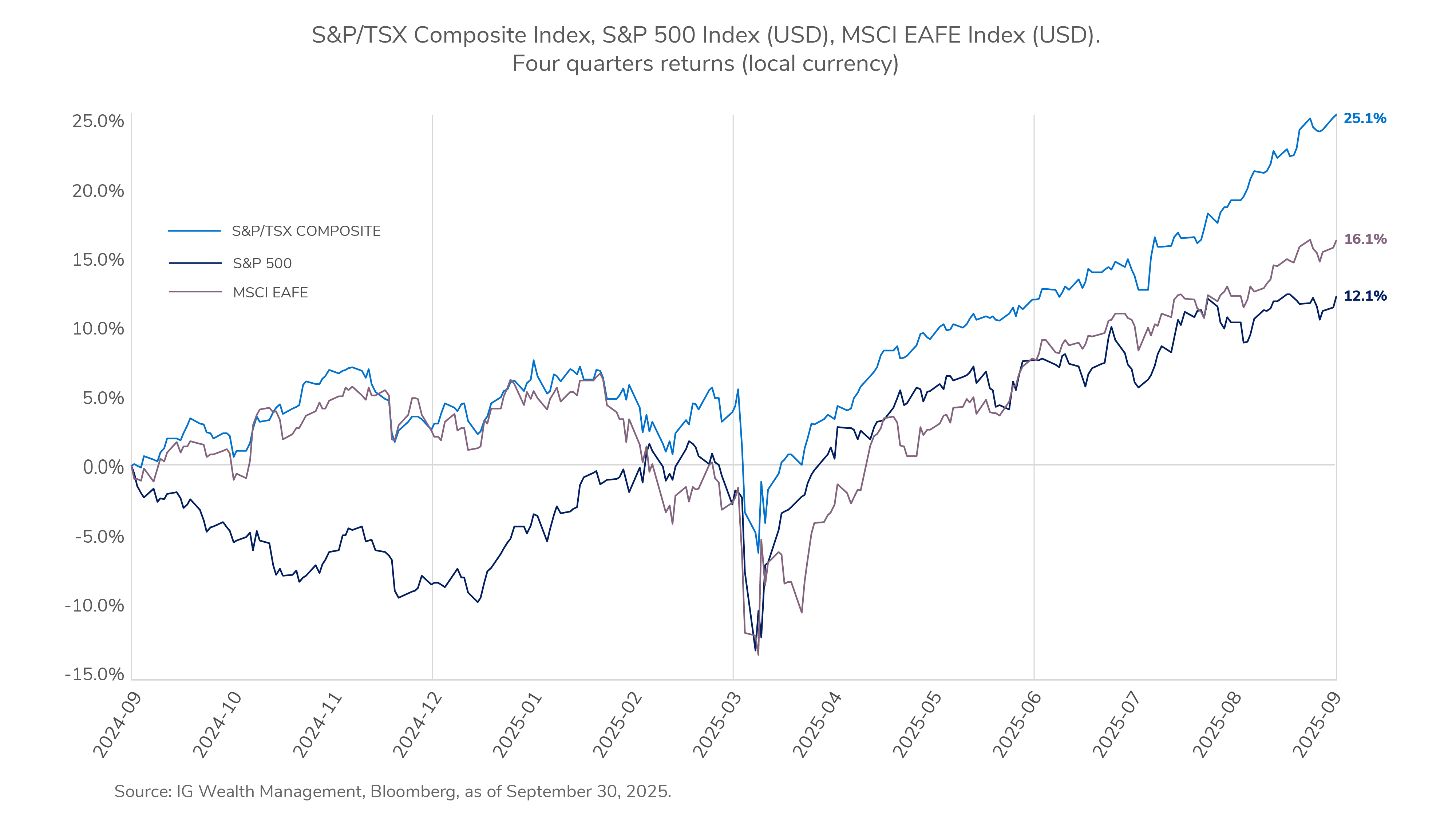Portfolio returns: Q3 2025
| Total Return | 1M | 3M | YTD | 1YR | 3YR | 5YR | 10YR | Since Inc. (Jun 22, 2020) |
iProfile Portfolio – Global Equity Balanced I | 3.32
| 6.52
| 12.26
| 15.18
| 16.09
| 10.31
| 10.62
| |
Quartile rankings | 3 | 3 | 2 | 2 | 2 | 1 |
Proudly Canadian
| Total Return | 1M | 3M | YTD | 1YR | 3YR | 5YR | 10YR | Since Inc. (Jun 22, 2020) |
iProfile Portfolio – Global Equity Balanced I | 3.32
| 6.52
| 12.26
| 15.18
| 16.09
| 10.31
| 10.62
| |
Quartile rankings | 3 | 3 | 2 | 2 | 2 | 1 |

The iProfile™ Portfolio – Global Equity Balanced, Series I rose over the period (by 6.5%) and outperformed its global equity balanced peer group median (6%). All component iProfile pools made gains, with the iProfile Emerging Markets Private Pool performing best, and the iProfile Fixed Income Private Pool delivering the weakest return. The portfolio benefited most from its North American equity components.
Global equity markets were mostly higher in the third quarter of 2025. The S&P/TSX Composite Index (12.5%), S&P 500 (10.5%), Dow Jones Industrial Average (8.0%) and Nasdaq Composite indices (13.9%) all touched record highs (all figures in Canadian dollars, total return). International markets, as reflected in the MSCI EAFE Index (7.1%) were higher, but several countries, including Germany, lost ground in local currency terms. Investors drew comfort, first, from trade deals (or outlines of trade deals) that reduced U.S. tariffs (or threatened tariffs) with many trading partners, reducing uncertainty. Secondly, economic data remained surprisingly solid, especially in the U.S., and contained inflation pressures that allowed several central banks to lower benchmark interest rates, including the U.S. Federal Reserve, the Bank of Canada and the Bank of England. As a result, the iProfile Canadian Equity Private Pool (8.7%), iProfile U.S. Equity Private Pool (9.3%), iProfile International Equity Private Pool (6.2%), iProfile Emerging Markets Private Pool (13.4%) and iProfile ETF Private Pool (9.7%), which together comprise just over 55% of the portfolio, accounted for more than three-quarters of the total portfolio return.
The iProfile Emerging Markets Private Pool was the top performer. It outperformed the MSCI Emerging Markets Index (in Canadian dollars, total net return), as all three of the component mandates in the pool delivered double-digit percentage gains, and two outperformed the MSCI benchmark. However, the pool’s overall contribution to portfolio gains was limited by its relatively low weight allocation. The pool’s absolute performance benefited most from an overweight allocation to, and stock selection in, the information technology sector. More than 30% of the pool is invested in the sector and it accounted for more than 45% of the pool’s total return. Almost two-thirds of that came from Taiwan’s and South Korea’s electronics giants, Taiwan Semiconductor Manufacturing Co. and Samsung Electronics, respectively.
The U.S. equity and Canadian equity pools were the top equity contributors to total return. The Canadian pool contributed most, in part due to its weight. However, it underperformed the U.S. pool and its Canadian equity benchmark S&P/TSX Composite Index. The Canadian equity pool’s relative underperformance was mainly due to stock selection in the financials and materials sectors, as well as an underweight exposure to the top-performing materials sector. The U.S. equity pool lagged the benchmark S&P 500 Index, mainly due to an underweight exposure to the technology sector, one of the top-performing sectors in the benchmark. Nonetheless, the information technology sector accounted for over 45% of the pool’s total return in the period.
The iProfile Fixed Income Private Pool (1.6%) is the largest component iProfile pool in the portfolio and so, despite its modest advance, contributed meaningfully to the portfolio’s total return. Global fixed income market returns were mostly modestly positive in the quarter, as bond yields slipped lower in North America but edged higher in Europe and Japan. Fiscal concerns (worries about increased government spending and inflation), in some cases related to political uncertainty, put upward pressure on bond yields in the U.K., France and Japan in particular. As a result, North American bonds outperformed international bonds. In both Canada and the U.S., corporate bonds slightly outperformed government bonds, with high-yield bonds outperforming investment-grade corporate bonds, as credit spreads narrowed. The multi-sector fixed income segment (managed by Manulife and added to the pool in late 2024) was the best-performing pool component. The IG Mackenzie Real Property Fund was the only pool component to lose ground and detracted from the pool’s return.
The third quarter delivered broad gains across asset classes, with market performance largely overriding a backdrop of cautious sentiment. Investors looked past persistent trade policy headlines, increasingly treating the U.S. administration's tariff policy as noise rather than a core risk. The primary catalysts for the positive performance were a subtle shift toward lower-interest-rate expectations and resilient corporate earnings.
Signals from the U.S. Federal Reserve of imminent rate cuts were followed by a quarter percentage cut in September. Government bond yields eased into the quarter's end, supporting bond prices, while corporate bonds outperformed government bonds.

Looking ahead, the normalization of inflation is a key development, providing central banks with the flexibility to begin an easing cycle over the next six to 12 months. This anticipated shift toward more accommodative monetary policy is expected to lower borrowing costs, creating a supportive foundation for economic activity.
This should help the macroeconomic environment sustain corporate strength. Earnings are projected to remain robust, building on a consistent trend of exceeding expectations. Resilient corporate profitability continues to be a primary driver of market performance.
The combination of impending rate cuts and durable earnings growth establishes a constructive outlook for equities. This environment reinforces the principle that focusing on underlying fundamentals, rather than reacting to short-term market volatility, is a prudent strategy for capturing future growth potential.
Commissions, fees and expenses may be associated with mutual fund investments. Read the prospectus and speak to an IG Advisor before investing. The rate of return is the historical annual compounded total return as of September 30, 2025, including changes in value and reinvestment of all dividends or distributions. It does not take into account sales, redemption, distribution, optional charges or income taxes payable by any securityholder that would have reduced returns. Mutual funds are not guaranteed, values change frequently and past performance may not be repeated. Mutual funds and investment products and services are offered through the Mutual Fund Division of IG Wealth Management Inc. (in Quebec, a firm in financial planning). And additional investment products and brokerage services are offered through the Investment Dealer, IG Wealth Management Inc. (in Quebec, a firm in financial planning), a member of the Canadian Investor Protection Fund.
This commentary may contain forward-looking information which reflects our or third-party current expectations or forecasts of future events. Forward-looking information is inherently subject to, among other things, risks, uncertainties and assumptions that could cause actual results to differ materially from those expressed herein. These risks, uncertainties and assumptions include, without limitation, general economic, political and market factors, interest and foreign exchange rates, the volatility of equity and capital markets, business competition, technological change, changes in government regulations, changes in tax laws, unexpected judicial or regulatory proceedings and catastrophic events. Please consider these and other factors carefully and do not place undue reliance on forward-looking information. The forward-looking information contained herein is current only as of September 30, 2025. There should be no expectation that such information will in all circumstances be updated, supplemented or revised whether as a result of new information, changing circumstances, future events or otherwise.
This commentary is published by IG Wealth Management. It represents the views of our Portfolio Managers and is provided as a general source of information. It is not intended to provide investment advice or as an endorsement of any investment. Some of the securities mentioned may be owned by IG Wealth Management or its mutual funds, or by portfolios managed by our external advisors. Every effort has been made to ensure that the material contained in the commentary is accurate at the time of publication, however, IG Wealth Management cannot guarantee the accuracy or the completeness of such material and accepts no responsibility for any loss arising from any use of or reliance on the information contained herein.
Trademarks, including IG Wealth Management and IG Private Wealth Management, are owned by IGM Financial Inc. and licensed to subsidiary corporations.
©2025 IGWM Inc.